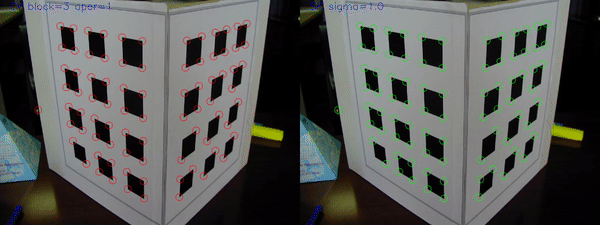I am using the opencv implementation of Harris Corner detection in python. My question is regarding the behaviour shown in the gif below – as the image is rotated the corners stop being detected (at various rotations). The full code:
import cv2
image_path = 'image1.jpg'
original_image = cv2.imread(image_path)
def play(video, name='video', wait=60, key='q'):
for f in video:
cv2.imshow(name, f)
if cv2.waitKey(wait) == ord(key):
return
def rotate(image, theta, point=(0,0)):
M = cv2.getRotationMatrix2D((point[1], point[0]), theta, 1)
return cv2.warpAffine(image, M, (image.shape[1], image.shape[0]))
def rotate_detect(image):
for theta in range(0, 360):
img = rotate(image, theta, (original_image.shape[0] / 2, original_image.shape[1] / 2))
gray = cv2.cvtColor(img, cv2.COLOR_BGR2GRAY)
dst = cv2.cornerHarris(gray,9,13,0.04)
#result is dilated for marking the corners, not important
dst = cv2.dilate(dst,None)
# Threshold for an optimal value, it may vary depending on the image.
threshold = 0.005
img[dst>threshold*dst.max()]=[0,0,255]
yield img
play(rotate_detect(original_image), wait=60)
cv2.destroyAllWindows()
based on this.
The image used can be found here. It is perhaps not so clear from the gif (more clear if you run the code), but the corners are detected when the grid lines are horizontal/vertical.
If the blocksize parameter is increased, we can get the desired behaviour (to detect corners at all rotations).
Question – How can the behaviour shown in the gif be explained?
Advertisement
Answer
Updated:
Use goodFeaturesToTrack() instead of using the manual code to retrieve the corners from the Harris response map.
You will have to adapt the blockSize and qualityLevel to your use case if you want to have correct results with OpenCV.
Left is DIPlib, right is OpenCV results.
DIPlib code:
from __future__ import print_function
from timeit import default_timer as timer
import diplib as dip
import numpy as np
import imageio
import os
img = imageio.imread('https://i.stack.imgur.com/hkbFD.jpg')
img = dip.Image(img)
img.SetColorSpace('rgb')
img = dip.ColorSpaceManager.Convert(img,'gray')
animation = []
times = []
for angle in range(0,360):
img_rot = dip.Rotation2D(img, np.radians(angle), '3-cubic', 'add zeros')
img_rot = img_rot.Pad(np.maximum(img.Sizes(), img_rot.Sizes()))
img_rot.Crop(img.Sizes())
start = timer()
harris = dip.HarrisCornerDetector(img_rot, sigmas=[3.0])
end = timer()
times.append(end - start)
harris *= dip.Maxima(harris, connectivity=2)
harris = dip.Dilation(harris > 1, 5)
harris = dip.Overlay(img_rot, harris)
harris.Convert('UINT8')
animation.append(harris)
print('Mean computation time: {:f}s'.format(np.mean(times)))
print('Median computation time: {:f}s'.format(np.median(times)))
print('Std computation time: {:f}s'.format(np.std(times)))
save_folder = 'DIPlib'
if not os.path.exists(save_folder):
os.mkdir(save_folder)
for idx, img in enumerate(animation):
imageio.imsave('{}/Harris_DIPlib_{:03d}.png'.format(save_folder, idx), img)
OpenCV code:
from __future__ import print_function
from __future__ import division
from timeit import default_timer as timer
import argparse
import numpy as np
import cv2 as cv
import os
parser = argparse.ArgumentParser(description='Test Harris corners rotation invariance.')
parser.add_argument('--input', default='', type=str, help='Input image path')
parser.add_argument('--save', default=False, type=bool, help='Save results')
parser.add_argument('--maxCorners', default=500, type=int, help='Maximum number of corners')
parser.add_argument('--qualityLevel', default=0.03, type=float, help='Minimal accepted quality of image corners')
parser.add_argument('--minDistance', default=11, type=int, help='Minimum possible Euclidean distance between the returned corners')
parser.add_argument('--blockSize', default=11, type=int, help='Size of an average block for computing a derivative covariation matrix over each pixel neighborhood')
args = parser.parse_args()
harris_params = dict(maxCorners = args.maxCorners,
qualityLevel = args.qualityLevel,
minDistance = args.minDistance,
blockSize = args.blockSize,
useHarrisDetector = True)
print('harris_params:n', harris_params)
image_path = 'hkbFD.jpg'
original_image = cv.imread(image_path)
def play(video, name='video', wait=60, key='q'):
idx = 0
directory = 'OpenCV'
if args.save and not os.path.exists(directory):
os.makedirs(directory)
times = []
for f, elapsed_time in video:
times.append(elapsed_time)
cv.imshow(name, f)
if args.save:
filename = directory + '/Harris_OpenCV_%03d.png' % idx
cv.imwrite(filename, f)
idx += 1
if cv.waitKey(wait) == ord(key):
return
print('Mean computation time: {:f}s'.format(np.mean(times)))
print('Median computation time: {:f}s'.format(np.median(times)))
print('Std computation time: {:f}s'.format(np.std(times)))
def rotate(image, theta, point=(0,0)):
M = cv.getRotationMatrix2D((point[1], point[0]), theta, 1)
return cv.warpAffine(image, M, (image.shape[1], image.shape[0]))
def rotate_detect(image):
for theta in range(0, 360):
img = rotate(image, -theta, (original_image.shape[0] / 2, original_image.shape[1] / 2))
gray = cv.cvtColor(img, cv.COLOR_BGR2GRAY)
start = timer()
harris_cv = cv.goodFeaturesToTrack(gray, **harris_params)
elapsed_time = timer() - start
for c in harris_cv:
cv.circle(img, (int(c[0,0]), int(c[0,1])), 8, (0,0,255))
yield (img, elapsed_time)
play(rotate_detect(original_image), wait=60)
Old:
Description of the algorithm
This paper analyses the implementation of the Harris corner detector.
@article{ipol.2018.229,
title = {{An Analysis and Implementation of the Harris Corner Detector}}, author = {Sánchez, Javier and Monzón, Nelson and Salgado, Agustín}, journal = {{Image Processing On Line}}, volume = {8}, pages = {305--328}, year = {2018}, doi = {10.5201/ipol.2018.229},}
The algorithm is the following:
Step 1 is not included in the original paper.
OpenCV Harris corner detection implementation
- with some specific conditions, Intel IPP library is used to extract the Harris corner
ippiHarrisCorner_8u32f_C1R()documentation- otherwise, the OpenCV implementation is roughly:
- Computes image gradient with Sobel
- Computes products of the gradients
- Box filter
- Computes the corner response
Scikit-image corner detection implementation
The code is straightforward:
Axx, Axy, Ayy = structure_tensor(image, sigma)
# determinant
detA = Axx * Ayy - Axy ** 2
# trace
traceA = Axx + Ayy
if method == 'k':
response = detA - k * traceA ** 2
else:
response = 2 * detA / (traceA + eps)
return response
with structure_tensor():
image = _prepare_grayscale_input_2D(image)
imx, imy = _compute_derivatives(image, mode=mode, cval=cval)
# structure tensore
Axx = ndi.gaussian_filter(imx * imx, sigma, mode=mode, cval=cval)
Axy = ndi.gaussian_filter(imx * imy, sigma, mode=mode, cval=cval)
Ayy = ndi.gaussian_filter(imy * imy, sigma, mode=mode, cval=cval)
return Axx, Axy, Ayy
and _compute_derivatives():
imy = ndi.sobel(image, axis=0, mode=mode, cval=cval)
imx = ndi.sobel(image, axis=1, mode=mode, cval=cval)
return imx, imy
OpenVX Harris corner detection specifications
It can be found here.
From these specifications, vendors can ship custom implementation optimized for their platform. For instance, the ARM compute library.
Comparison between OpenCV and Scikit-image.
- Versions used:
OpenCV: 4.2.0-dev Numpy: 1.18.1 scikit-image: 0.16.2
- Harris parameter
k=0.04 - OpenCV Harris function parameters that are modified, default values for the experiments are:
blockSize=3andksize=1 - Scikit-image Harris function parameter that is modified, default value for the experiment:
sigma=1 - Left: OpenCV results; Right: Scikit-image results
Sudoku image
- default parameters:
- OpenCV:
blockSize=7,apertureSize=3; Scikit-image:sigma=5:
Repeatability rate can be computed, but not sure that my code is totally correct:
Distance threshold is 5.
From my experiments, it looks like Scikit-image yields better corner location accuracy.
Blox image
- default parameters:
- OpenCV:
blockSize=3,apertureSize=3; Scikit-image:sigma=3:
OP Sudoku image
- default parameters:
- OpenCV:
blockSize=7,apertureSize=3; Scikit-image:sigma=7:
Calibrator image
- default parameters:
Code is here.











